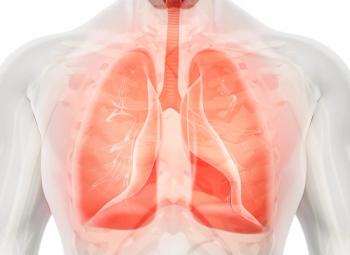
- ONCOLOGY Vol 26 No 2
- Volume 26
- Issue 2
Lung Cancer Screening: A New Era
Screening is always an issue that generates a great deal of emotion, as recently seen with the controversies surrounding mammography and prostate-specific antigen (PSA) testing.
Screening is always an issue that generates a great deal of emotion, as recently seen with the controversies surrounding mammography and prostate-specific antigen (PSA) testing. The role of screening is to detect cancers early in asymptomatic individuals, with a goal of facilitating timely intervention to decrease morbidity and mortality. The key words/concepts in the foregoing sentence are “asymptomatic,” “intervention,” and “decreasing morbidity and mortality.”
To understand the issues involved, a brief discussion of some of the problems with screening is appropriate. The concepts of sensitivity and specificity, as well as positive and negative predictive values, need to be considered. The ideal screening test should have a relatively high degree of sensitivity; that is, the percentage of people with the disease who have a positive test should be high. (The number of true positives divided by the number of true positives and false negatives should equal a high percentage.) In addition, an ideal screening test should have a high degree of specificity; that is, the percentage of people who do not have the disease and who have a negative screen should also be high. (The number of true negatives divided by the number of false positives and true negatives should equal a high percentage.) A good screening tool should also have a high predictive value; that is, a high percentage of patients with positive results should actually have the disease. (The number of true positives divided by the number of true positives and false positives should equal a high percentage.) Finally, a good screening test should have a good negative predictive value; that is, a high percentage of patients with negative results should really not have the disease. (The number of true negatives divided by the number of false negatives and true negatives should equal a high percentage.)[1]
Lung cancer is a disease for which a significant screening tool would seem to meet the criterion of being able to significantly decrease morbidity and mortality by facilitating early intervention. In contrast to prostate cancer and even some breast cancers, lung cancer generally is not an indolent disease. There is no question that early intervention can improve the 5-year survival of patients with non–small-cell lung cancer (NSCLC). Close to 80% of patients can achieve a 5-year survival when diagnosed at stage I. Clearly, early surgical (or other) intervention for patients with lung cancer can have a significant impact on survival. Therefore, screening for early-stage disease would make sense.[2]
The problem has been that until recently no screening techniques have been shown to make a significant difference in survival outcomes. With the recent publication of the study by Aberle et al in the New England Journal of Medicine, we now seem to have a screening tool that can potentially improve survival in NSCLC. In their report of the National Lung Screening Trial results, Aberle et al demonstrate that low-dose CT scanning (LDCT) can reduce mortality by 20%.[3] This screening modality seems to have a reasonably high degree of sensitivity but suffers from a low degree of specificity; to wit, of the 24% of CT findings that were positive, 96% were noncancerous. The cost of screening with LDCT is reasonable with regard to the cost of the test itself (about $100 per test in our community). However, because of the associated costs of evaluating false-positive findings and of managing the complications associated with these investigations, the overall cost of screening with this particular modality is significantly more. Ongoing efforts to reduce both expense and morbidity are needed.
Tanner et al do an excellent job of reviewing the current status of screening in NSCLC. They provide a good review of the history of lung cancer screening, showing the appropriate negative studies that have been done in the past with chest x-rays, sputum cytologies, and bronchoscopic evaluations. In addition, the authors of this review do an excellent job of pointing out some of the problems with the study of LDCT. A main issue is the high number of false-positive tests requiring further extensive evaluation (ie, low specificity). Another problem is that the study was done primarily in urban settings and at academic institutions where dedicated physicians and departments were used both to evaluate the screening tests and to perform further evaluations. With this somewhat selective population of urban patients followed at tertiary centers, it is hard to know whether the conclusions based on the data these investigators collected would be applicable to a more general community population.
We think it is also important to note that the screening in this particular study, as Tanner et al have pointed out, was done in a selected high-risk population of heavy smokers at clear risk for death from this aggressive disease. This aspect of the study is key to an important distinction between LDCT screening for lung cancer and PSA and mammographic screening, both of which are focused on the general population at modest risk rather than on a subset of the population at high risk. The authors also provide an excellent review of a number of new, potentially exciting screening modalities that may help to improve the yield of screening in NSCLC. Although as yet unproven, bronchoscopy with light-induced fluorescence could improve the sensitivity and specificity of LDCT-although at a significant cost. Serum testing for tumor antigens and autoantibodies might provide a relatively noninvasive way of improving screening yield by further enhancing the high-risk pool of patients being screened, either before or after LDCT. Again, however, the appropriate trials would need to be done to prove the effectiveness of this approach. Breath analysis offers some of the same opportunities to improve specificity and sensitivity, especially when combined with other screening modalities. Each of these modalities has advantages and disadvantages with regard to sensitivity, specificity, and cost, and would have to be vetted in the appropriate clinical trials.
We would like to address one of the objections raised by the reviewers, namely, that the patient population in the North American National Lung Screening Trial was somewhat selected, being primarily urban and screened by institutions with a dedicated program and staff, and thus lacked generalizability to a community setting. We want to point out that this type of program can be instituted in a community-based setting. Because of the high incidence of lung cancer in Northeast Florida, community-based efforts are underway to initiate a series of trials to determine the role of screening with noninvasive breath-, blood-, and sputum-based technologies, first for patients with pulmonary nodules and subsequently for the population at large. Our effort involves medical oncologists, radiation oncologists, radiologists, pathologists, pulmonologists, and thoracic surgeons-across a number of potentially competing Northeast Florida institutions. The trial will accept patients with pulmonary nodules found either by chance or by LDCT screening. Participants will have a PET/CT scan, as well as innovative, noninvasive breath, blood, and sputum tests. Management will be by Fleisher Society guidelines. The hope is that by combining a number of noninvasive, relatively inexpensive techniques, we can improve both the sensitivity and specificity of lung cancer screening.
Tanner et al are to be applauded for an excellent review of the current state of lung cancer screening and for offering some new methods for improving screening outcomes. It is encouraging that we now have an opportunity to improve survival in this aggressive disease.
Financial Disclosure: The authors have no significant financial interest or other relationship with the manufacturers of any products or providers of any service mentioned in this article.
References:
REFERENCES
1. American Society of Clinical Oncology Self-Evaluation Program (ASCO-SEP). 3rd ed. Chapter 1: Epidemiology and prevention. [2011 draft manuscript]
2. Goldstraw P, Crowley J, Chansky K, et al. The IASLC Lung Cancer Staging Project: proposals for the revision of the TNM stage groupings in the forthcoming (seventh) edition of the TNM Classification of malignant tumours.
J Thorac Oncol. 2007;2:706-14.
3. National Lung Screening Trial Research Team. Aberle DR, Adams AM, Berg CD, et al. Reducing lung cancer mortality with low-dose computed tomographic screening. N Engl J Med. 2011;365:395-409.
Articles in this issue
over 13 years ago
New Testing for Lung Cancer Screeningover 13 years ago
The Maze of PARP Inhibitors in Ovarian Cancerover 13 years ago
AL Amyloidosis: Who, What, When, Why, and Whereover 13 years ago
AL Amyloidosis: New Drugs and Tests, but Old Challengesover 13 years ago
Formidable Challenges Ahead for Lung Cancer Screeningover 13 years ago
Splenic Lymphomas: Is There Still a Role for Splenectomy?Newsletter
Stay up to date on recent advances in the multidisciplinary approach to cancer.



















































































